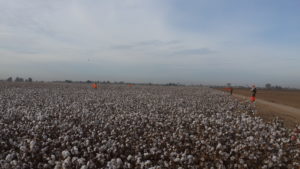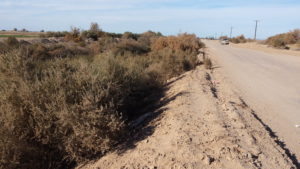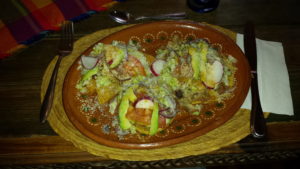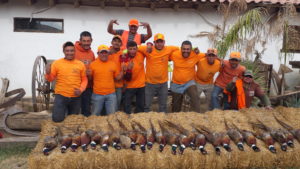Archive for January, 2018
The Land of Yes
I love these shows. I guess I’ve been attending them for as long as they’ve been around. Right after each New Year, I start thinking about the Washington Sportsman Show in Puyallup, our neighborhood Central Washington Sportsmen Show, and others I can attend.
Cousin Ron Tanquary insists that each show is a journey to “The Land of Yes!” That started a couple decades ago, after we had wandered down several aisles of the year’s first. I remember the look on his face as he chuckled “Listen to us… We just keep saying ‘Yes,’ ‘Yes,’ ‘Yes!’ at every booth we pass. We wander all these paths, lost in some brochure, mounted fish, antlers, photos, videos or sales pitch. Some girl or guy says, ‘You wanna salmon fish in Canada?’ We say, ‘Yes…’ ‘Wanna hunt New Zealand?’ We say, ‘Yes…’ ‘Wanna win this new Ruger or Kimber?’ and we say ‘Yes! Yes!’ Cousin, we are afield in The Land of Yes!”
Thus, I prepare to wander The Land of Yes for the next couple months. I look forward to the SunDome and Portland in February, and enough adventure to handle another year of reality – maybe. To that end, I shall this weekend journey to The Land of Yes (Washington Sportsmen’s Show) at the Puyallup Fairgrounds. (Check out www.thesportshows.com/shows/washington/.) I have things and people to see there.
Having never fully recovered from being owned by Freebe the Wonder Dog, I’m hooked on Labs and hunting dogs. I look forward to visiting with trainers and owners, and to watching kids with pups, as they realize that a dog is the only true friend that can be bought.
I will check in with survival pro Brett Stoffel. He will either be in his comfortable Toyota camp (warming himself and friends with stories around a small stove) or at one of his daily survival seminars. Brett has helped many folks and families overcome the odds, and survive tough conditions off the beaten path, using simple tools as lifelines.
I expect to learn a few things on the Indoor River, as two of my heroes, Joe Rotter and Shane Magnuson maybe get through my thick skull what it takes to coach a trout out of a tight spot.
That brand new, specially-built kokanee tank is a must. This is the first time kokanee have ever been raised to this size in a hatchery environment for display and demo purposes. Pros from Mack’s Lures will cover kokanee fishing under every condition and in every season.
Having managed to hunt an entire late bull elk season without finding a bull, I need to see the “Northwest Tour of Big Game Animals.” It features a remarkable collection of record-setting bulls (and deer and other critters), and it may help me remember what they look like. There will also be that huge whitetail buck – biggest on record in the Northwest – and the recently-taken heads and horns being measured in this year’s competition.
No doubt, I will watch youngsters fishing at the Baxter “Kid’s Free Trout Pond” for a while. There is just something ancient and timeless about watching a boy or girl hook and land a trout, and their excitement about bringing home a fresh fish for the family.
Certainly, I will follow my nose to the Camp Cooking Demo Tent. The Haugens, Bethy Rossos, and others will show me – as they have every year – a game cooking technique or two to make my life better.
There is so much at these shows to which one might say “Yes!” Still, overall, education is always a major draw. During the five days of the Washington Sportsmen’s Show & Sport Fishing Boat Show, there are more than 200 hours of seminars with experts on every sort of hunting and fishing found in Washington. When I ask folks why they come to the shows, these learning opportunities are always near the top of their list. We all fantasize about being the best at something, and it starts with expert mentoring.
Concurrently with each of my visits to The Land of Yes, there will be held meetings of the Reecer Creek Rod, Gun, Working Dog & Outdoor Think Tank Benevolent Association. The primary agenda item for this year’s meetings will be work underway in our Washington State Senate to create a Washington Children’s Outdoor Bill of Rights. On future banners we hope to see “The children of Washington have the right to discover and experience the outdoors through the following activities: Create an outdoor adventure; Explore a trail; Camp under the stars; Go fishing; Go hunting; Discover nature; Ride a horse; Explore Washington’s heritage; Go on a picnic; Play in a park, in the water, in the snow, on the rocks.” Join the conversation.
Over this weekend, I expect to win firearms and new gear. In my pocket will be winning tickets for a fishing trip out of Westport or Ilwaco, a fully outfitted 17-foot water sled and a safari in New Zealand. I know I will win all these things, I just hope that – this year – they remember to call me when my name comes up.
Take the drive to The Land of Yes in Puyallup, Washington. Every hunting, fishing or getting outside adventure to which you want to say “Yes!” is awaiting you there. Then plan your visit to the Yakima SunDome in a few weeks. These are the pleasures that get us through winter.
Comments Off on The Land of Yes
Start 2018 with Driven Mexican Birds
You may recall that Kevin Clements and I teamed up for that 2016 trip to South Africa to play with friends Richard and Ruth Lemmer, owners of Safari Afrika. In addition to a few other critters, we invested enough time and laughter in francolin, Guinea fowl, and various species of doves to entertain thoughts, on several occasions, about bird hunting on our continent. Kevin is a bird hunting nut.
Some months back, Kevin suggested I might enjoy a long weekend of hunting driven ring-necked pheasants and Gambel’s quail, with maybe some pass shooting of doves, in sunny Mexico. The more we talked, the more it seemed a pretty good way to get 2018 off to a proper start. We would book with Gordie White’s Expedition Adventures and hunt Arturo Malo’s Baja Hunting ground. All it would cost me was airfare to San Diego, a couple hundred shot shells, and tips for the bird boys and a couple others who would ensure our great time.
Seemed out that Kevin and three of his Ruffed Grouse Society buddies and long-time friends had tested those Mexican quail covers at the beginning of 2017. They wanted to go again – with additional family members. Sadly, the hunts require sets of four and by the time sons, fathers and grandson were added, they had an odd number – seven. Clearly, once they identified the need for an odd person, I was the obvious choice.
Once settled, our party of eight included Kevin Clements and his dad Larry, Colonel Doug Forsythe and son Tom, and Bob Olson, with son Andy and grandson Zack. I was welcomed as family – maybe like one of those uncles nobody mentions in polite company. Be that as it may, we had young guns, old guns and some in-between. This would be fun.
Thus, at dark-thirty a.m. on the first Friday of 2018, we found ourselves lifting off to San Diego International. There, we reclaimed shotguns and gear, and loaded into the Baja Hunting van to Mexicali and the Mexican border. The Federales were friendly, efficient, courteous, and welcomed us and our cased shotguns to their country. We easily slipped across the border, about a half hour from our weekend home, a bit southwest of Yuma, Arizona.
At Baja Hunting HQ, we checked into our rooms, had a quick bite, and headed out to an afternoon of mourning dove shooting. We met our bird boys; they spotted incoming doves, cheered when we connected on the darting rockets and retrieved those we hit. Humbling. Brian, my new best friend bird boy, was kind enough to note that 12% was not bad for the first afternoon. That evening, as after each half-day hunt, the bird boys cleaned the birds for the cooks’ magic.
The next two mornings we were off to cotton fields, and the occasional milo patch, for driven pheasants. Two afternoons and our final morning we sought brushy draws and thickets for Gambel’s quail – similar to our California quail, with a bit more color.
These driven hunts were worth the price of admission. For pheasants, the eight bird boys – Brian, Bernie, Edgar, Luis, Pepe, Kiko, Ruly, and Oscar – would line up across the far end of a cotton or milo (grain sorghum) field. The shooters (us) would take positions along the near end. Everyone wore orange (hat and/or vest) for visibility and safety. Field hunt managers Tino and Pancho kept everything in order for Baja Hunting owners Arturo and Rachel Malo. On a signal, the bird boys pushed forward in a rising cacophony of sound.
Imagine a blend of these loud sounds from eight untiring and enthusiastic young men: “Yi, Yi! Arriba! Ya, Ya! Kya, Kya! Yip, Yip! Avante, Avante!” Throw in lines from Mexican folk songs, loud, rhythmic clapping, and a dog bark that had me looking around, and you may sense the wonder of each drive. When pheasants burst into the air it was “Hen! Hen!” or “Rooster!RoosterRooster!! Shoot ‘im! Shoot ‘im!” As roosters went down, the boys found them wherever they were in the tangled cover. Each bird found was cause for celebration – like some new world record.
Repeat for the quail, except we hunted brushy draws and woodlots in groups of four. Same rising crescendo and excitement, and now it was “Quail coming! Quail!Quail!Quail!! Shoot ‘em! Shoot
‘em!” One other difference: the quail were smaller and flashier and closer to the ground – and jet propelled right under our noses. Fast and furious shooting… Downright embarrassing now and again, even as the bird boys cheered us on.
All our birds were cleaned and prepared in terrific dishes by a skilled and smiling kitchen staff under Rachel’s watchful eye. We had dove and quail hors d’oeuvres, pheasant and quail tamales, tacos, cordon bleu, molé, tostadas, and several other amazing foods. At one point someone observed that our fine meals were all Mexican food, to which the response was “Duhhh…”
After that last quail hunt Monday morning, we cleaned up, packed our guns and gear and frozen treasures (pheasant or quail tamales or cordon bleu or molé), and piled into the rig for the trip back to the U.S. …Back to the lives we live between outdoor adventures.
[Find out about Arturo and his wide variety of Mexico hunting opportunities at www.bajahunting.com. For more info or to book a hunt, reach out to Gordie White’s Expedition Adventures at 830-483-0796 or gwhunts.com/.]
Thanks, Kevin, for sharing your buddies on this great start to time afield in 2018.
Comments Off on Start 2018 with Driven Mexican Birds
The Pautzke Bait Company (A National Treasure)
Just before the end of the year, I visited a national treasure – just down the street, on Dolarway, right here in Ellensburg, Washington. Homey Bill Boyum works the rush season, and gave the management a heads up for me. He figured, given all the times he’d heard me talking about fishing with those “Soft but Satisfying,” “Balls O’ Fire,” eggs as a kid, I was long overdue for my pilgrimage to the Pautzke Bait Company.
I easily remember that sunny spring Saturday morning on Lake Wenatchee in the early 1950s, when Earl English pulled out a new jar of Pautzke eggs and smiled. “Soft but satisfying,” he chuckled, “that is always a good thing. Trout love ‘em.” I was probably 11 or 12, too young to get the joke, but I dutifully chuckled and started fishing with the new single-egg hooks Eagle Claw had designed just for the salmon eggs. I couldn’t tell you what we caught that day, but I can tell you we always had a jar of those eggs and we never got skunked.
Earl was the big kid from up the block in East Wenatchee, on the east side of the Columbia River. He was funny, he knew everything, he drove, he fished, he loaded ammo and shot targets from his upstairs bedroom window, he hunted, and he somehow took me under his wing. He often described me as a “pesky pup” chewing on his pants cuff, but he kept me around. He was my first – maybe greatest ever – outdoor hero.
At any rate, I’ve often thought we were among the first fans of those Balls O’ Fire when they began conquering Washington’s fishermen – and fish.
One of the company’s bylines is “Soft but satisfying since 1934.” In those first days, Ernie Pautzke was cooking up some especially effective salmon eggs at home. Right after WWII, Ernie’s nephew, Keith Williams (grandfather of current owner Casey Kelley) bought the recipe from him for 50 bucks and started Pautzke Bait as a way to fully live his outdoor lifestyle. It was tough early on; those king salmon eggs were deadly effective, but just didn’t sell. Williams gave away most of his first 200 cases, and took on some other work to feed his family. Pautzke Bait finally sold 20 cases in 1949.
Keith Williams always credited his wife, Marnie, with Pautzke Bait’s rise to prominence. At some point in the very late 1940s, she suggested that he dye the eggs a bright red. The rest is history. (I do know that, while Earl and I used Pautzke’s natural pale orange eggs, we always carried those bright beautiful “Balls O’ Fire” reds.) Today, the company still revolves around those bright fluorescent eggs – also available in natural, chartreuse, orange, pink, yellow and sparkly. There are a half-dozen other fish-catching products and colors as well. Today, Pautzke baits are sold in mom-and-pop stores and retail giants all over North America and Mexico – you would not be surprised to see them being used in Europe and Africa.
Pautzke Bait is part of our fishing culture. In the last Century, some four decades ago, I was debating greenback cutthroat trout fishing with one of my fly-fishing nut buddies along the South Platte River southwest of Denver. I suggested worms and Balls O’ Fire and he snorted about how a real fisherman used hand-tied flies which imitated only the natural things fish ate. In one corner of his well-stocked fly box I saw a small, round, fluorescent red thing that looked a lot like one of Pautzke’s best. “You tie that, too?” I asked. He didn’t want to talk about it.
My end-of-2017 tour of Pautzkeland? It was great.
I walked into the large processing and shipping room, and waited to chat with owner Casey. I was standing in a forest of five-gallon buckets holding hundreds of gallons of raw, light orange salmon eggs waiting to be cooked and processed. (For the last four-plus decades, the eggs have been sourced from the Great Lakes – a much more reliable source of Chinook salmon eggs than the original sources in Alaska and Canada.) The wait gave me a chance to look around.
This is the hectic time of year for Pautzke, and a couple dozen very busy workers were at key locations in the various processing and shipping sections of the warehouse. Two or three folks were cooking and stirring eggs, another was examining and testing a vat of dye, and others were overseeing the ancient machines which filled and sealed the jars. Along a conveyer and roller belt, men and women were counting and boxing and shrink-wrapping jars of fishing magic. At the end of that line, a couple guys loaded cases onto pallets and prepared them for shipping to the store where some teenaged guy or girl will grab a jar so that they can teach a pesky pup youngster how to catch his or her own food and begin a lifetime of outdoor pleasure. There wasn’t much talk in that big busy production room, but most everyone was wearing a relaxed look or smile.
How could it not be like that? These men and women are integral parts of an American National Treasure: the Pautzke Bait Company of Ellensburg, Washington.
Come on, spring!
Comments Off on The Pautzke Bait Company (A National Treasure)
Sourdough and Many New Years
2018. Wow. A new year shows up and my life shifts around for some new focus. While I eagerly anticipate the coming sportsmen shows – home of those several-days-long outdoor fantasies – I am just not quite ready to let go of the past.
Consider that I haven’t been fishing or hunting since last year. All my outdoor gear dates back into the last century, and… Well you get the idea. Then there is that treasure which dates back to the century before last.
We just returned from a too-short visit with the last of the Hucklings, in Colorado. When we were making arrangements for our after Christmas celebrations, Edward asked if his sister or mom were planning to make sourdough pancakes, to ensure that 2018 got off to a proper start. It made sense, really, since our sourdough starter has been a regular part of welcoming our family’s new years and has seen a good many others as it lived and grew through parts of three centuries.
Each time I add flour and water to the starter, the mixture grows and expands and behaves much as I imagine it did for the old Alaskan gentleman who brought it to western Washington around a couple turns of a century back. He passed some of the culture on to a young couple there in 1915. He told them he had no idea how long it had been since another old miner handed it off to him. My folks got some of it in 1960, and passed a share on to me in 1965. In turn, there are now crocks of the starter in any number of family and friend homes.
Funny how people get attached to stuff like sourdough. That living culture of natural yeast becomes part of the family. There is, no doubt, an infinite variety of fine old starters ranging from really sour to almost sweet to the nose and tongue. I’ve tried dozens across the U.S. over the decades. (One in Roslyn makes the finest bread you ever munched over a poker game.) I remain pretty smug about mine, which is remarkably mild, with a sourness easily controlled with the clock. Diane makes an outstanding bread with ours, insisting that it is the easiest bread she has ever made. Many odes and essays have been written to celebrate the wonders of sourdough.
I took gallon jugs of sourdough batter to our Colorado elk camps for many years. The poems celebrating those high-country pancakes were creative and joyful – if inappropriate for a family newspaper.
On the premise that every outdoor nut needs a specialty meal and/or food, I have passed parcels of my starter along many times. Over the years any number of homeys have mastered biscuits, bread and pancakes with it, often collecting some pretty interesting literature. One of them, Homey Mark Dunbar, has often recommended Jake O=Shaughnessey=s Sourdough Book. O=Shaughnessey calls the water-flour-starter mixture “ambrosia,” and no sourdough aficionado would argue the point.
As we aficionados hand off our treasured starters, we all warn about allowing for the redoubling of volume as the sourdough yeast culture grows through the ambrosia. Some people get so excited with their new starter that they miss part of the guidance.
In the late 1980s, I passed a crock along to Brad Johnson, editor of the paper for which I was writing the earliest of these “Inside the Outdoors” columns. Brad mixed it up, then left it unattended in his truck on a relatively warm day. Brad’s resulting story, under the headline “The Sourdough that Ate Castle Rock, Colorado,” told of it spreading from his truck, creeping downtown, and clearing the way for a new downtown improvement project. After seeing his truck, I have always pretty much believed Brad’s tale.
In October, 1968, John Jobson, the long-time camping editor for Sports Afield magazine, wrote a column titled “That Wonderful Sourdough.” He suggested making your own starter, with the following simple instructions. Into a gallon crock (a very large glass or ceramic bowl will do, too) put four cups flour, two tablespoons sugar, a tablespoon of vinegar and enough water to make a syrupy batter. Cover it loosely (cheesecloth is good) and keep it warm, not hot. Natural yeast will settle onto the mixture and in ten days or so you will have your own unique starter. Pour off any clear, yellow liquid, add water and flour, and wait as it bubbles and grows. The world is full of recipes for everything from pancakes to cornbread and desserts, just check the library or web, or contact me.
Near Seattle, Jobson (on a movie tour for MGM’s 1933 movie, Eskimo) once picked up huskies, a sled, harness and snowshoes from the rural lakeside cabin of an old Alaskan prospector who had gone on to his reward. As he was leaving, he noticed the old boy’s dry and crusty sourdough jug, at the back of the old wood stove. The auctioneer (with curled lip) scoffed, “Take it!”
With water and flour added, the sourdough in that crusted old pot came alive. It made, Mr. Jobson said, “some of the finest and most toothsome bread I’ve ever eaten.”
I think Jobson would describe Diane’s bread that way, too. I like imagining that the old prospector whose sourdough Jobson rescued was the guy from whom my starter came.
Happy New Year.
Comments Off on Sourdough and Many New Years











